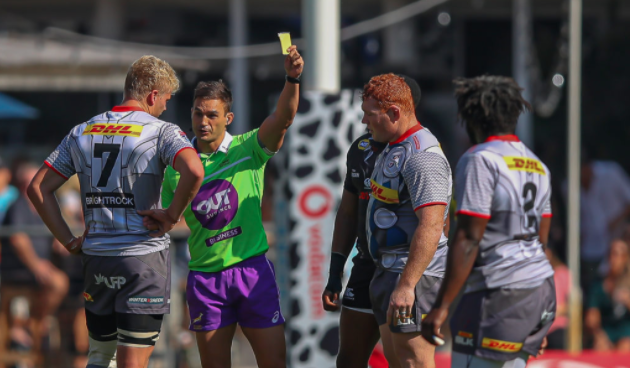Mariette Adams and Dylan Jack debate whether referees should allow a red-carded player to be replaced after a certain period of time.
Jack says yes:
This past weekend’s latest farce involving Stormers flank Johan du Toit and referee AJ Jacobs should be a sign that urgent intervention is needed when it comes to the red-card rule.
In an incident mirroring Kwagga Smith in the 2017 Vodacom Super Rugby final, Du Toit took the Sharks’ Louis Schrueder out in the air, causing the scrumhalf to land dangerously and get concussed as his head whiplashed on to the ground.
Only, in the 2017 final, referee Jaco Peyper had the guts to make a massive call in a crucial stage of the game, showing some empathy but nevertheless sending Smith off.
Unfortunately, despite the insistence of TMO Willie Vos, Jacobs decided that Du Toit’s tackle merited only a yellow card – probably a wrong decision given that Du Toit was cited after the match.
In a SuperSport discussion of the incident, former Bok coach Nick Mallett suggested the fact that it took place 10 seconds into the match played a role in Jacobs’ decision. He went on to say a possible solution would be to allow a team to replace a red-carded player after 20 minutes.
This is something that has already been trialed at the Varsity Cup, with some success. The law takes away the element that a red card causes an unfair contest as it allows 14 vs 15 for only a short period of time, while still punishing both the team and the player.
If implemented at a higher level, it would take away a referee’s fear that he or she may be responsible for ruining the match for spectators and allow them to focus on only the decision at hand. This is something that needs urgent review from World Rugby if decisions are to become more consistent.
Adams says no:
While I agree that the taking-out incident and the referee’s subsequent failure to hand down the harshest punishment could be a sign that intervention is needed, I believe intervention should be focused on the correct and consistent application of the laws by match officials – instead of taking mitigating factors into account.
A red card has an enormous effect on the result of a match – especially if it is handed out early in the game.
Many argue that it is unfair to the remaining 14 players (22 if you include the substitutes), who have not offended. It ends the match as a contest, which in turn ruins the entire experience for spectators. So all in all, a red card equals … Game. Set. Match.
It is for that reason that Nick Mallett, as so often in the past, spoke out about introducing a law that has a red-carded player serve a standard amount of time in the sin bin before then exiting the game and allowing his team to bring on another player.
Red cards may sometimes be distributed in an unfair manner (Bismarck du Plessis against the All Blacks in 2013 a case in point), but more often than not they reflect the correct decision. They may be handed out when a player injures an opponent as with Du Toit on Schreuder, or when a player deliberately starts a fight in order to get their target sent off as well as in France versus Scotland in the Six Nations a couple of weeks ago. There are many more appropriate examples.
In these scenarios, red-card offenses are rational decisions taken by the player to produce a tangible benefit for his team. It just so happens these benefits are obtained against the rules.
If red-card offenses were unproductive, they would be exceedingly rare. Hence, the purpose of the red card is to create a negative consequence that outweighs any potential benefit of breaking the rules.
Much like football, rugby is a team sport where they like to throw the old cliche of ‘win together, lose together’ around. (Well, unless it’s Liverpool FC, then the phrase is something like: ‘Win together, lose and it is the goalkeeper’s fault.’ But I digress.)
When a player transgresses and gets away with it, the entire team benefits; so if he doesn’t get away with it and earns himself a red card, the team shares in the punishment collectively by playing with 14 men for the rest of the game.
Talking point: Du Toit’s yellow card
Photo: Gordon Arons/Gallo Images





